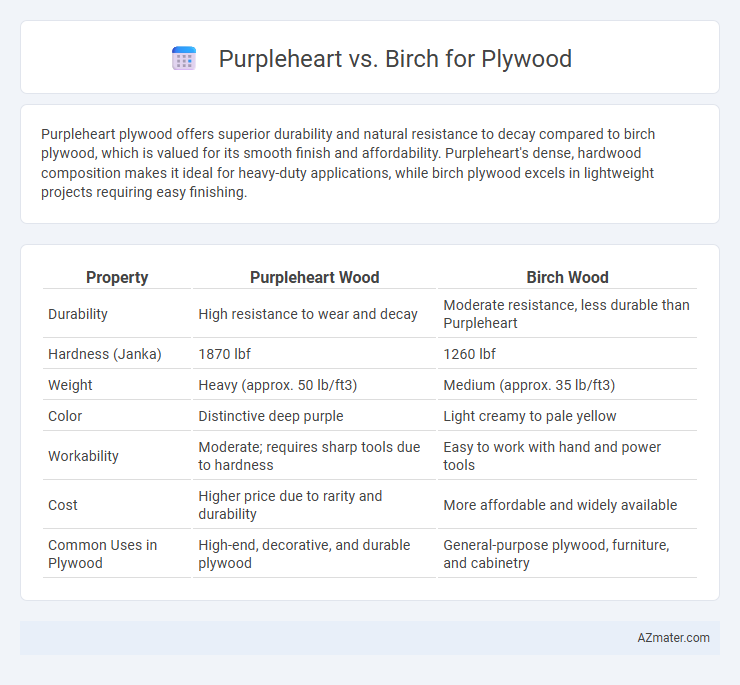Purpleheart plywood offers superior durability and natural resistance to decay compared to birch plywood, which is valued for its smooth finish and affordability. Purpleheart's dense, hardwood composition makes it ideal for heavy-duty applications, while birch plywood excels in lightweight projects requiring easy finishing.
Table of Comparison
| Property | Purpleheart Wood | Birch Wood |
|---|---|---|
| Durability | High resistance to wear and decay | Moderate resistance, less durable than Purpleheart |
| Hardness (Janka) | 1870 lbf | 1260 lbf |
| Weight | Heavy (approx. 50 lb/ft3) | Medium (approx. 35 lb/ft3) |
| Color | Distinctive deep purple | Light creamy to pale yellow |
| Workability | Moderate; requires sharp tools due to hardness | Easy to work with hand and power tools |
| Cost | Higher price due to rarity and durability | More affordable and widely available |
| Common Uses in Plywood | High-end, decorative, and durable plywood | General-purpose plywood, furniture, and cabinetry |
Introduction to Purpleheart and Birch for Plywood
Purpleheart plywood, sourced from the dense and durable Peltogyne tree native to Central and South America, is prized for its vibrant purple hue and exceptional hardness, offering superior resistance to wear and fungal decay. Birch plywood, derived from North American birch trees, is known for its fine grain, pale color, and impressive strength-to-weight ratio, making it a popular choice for cabinetry, furniture, and general woodworking projects. Both woods provide distinct aesthetic and structural advantages, with purpleheart delivering unique visual appeal and durability, while birch offers versatility and ease of finishing in plywood applications.
Botanical Origins and Tree Growth
Purpleheart plywood originates from trees in the Peltogyne genus, native to Central and South American rainforests, known for their slow growth and dense hardwood. Birch plywood is derived from species in the Betula genus, predominantly found in temperate Northern Hemisphere regions, where birch trees grow faster and produce a lighter, less dense wood. The slower growth of purpleheart trees results in a tighter grain and higher durability compared to the quicker maturing birch trees used in plywood production.
Color, Grain, and Aesthetic Differences
Purpleheart plywood features a distinctive deep purple hue that darkens with age, offering a bold and unique aesthetic compared to birch's light, creamy color. The grain of purpleheart is typically straight and fine, providing a smooth texture, while birch plywood displays a more consistent, tight grain with subtle waves, enhancing a classic, clean look. These color and grain contrasts make purpleheart ideal for statement pieces, whereas birch suits projects requiring neutrality and versatility in design.
Mechanical Strength and Durability
Purpleheart plywood exhibits superior mechanical strength compared to birch plywood, with a higher Janka hardness rating of 2,520 lbf versus birch's 1,260 lbf, making it more resistant to wear and impact. Its dense, oily fibers contribute to enhanced durability and natural resistance to rot and insect damage, ideal for heavy-duty applications. Birch plywood, while less robust, offers excellent stability and smooth finish but typically requires additional treatments to match the longevity of purpleheart in demanding environments.
Workability and Machining Properties
Purpleheart plywood offers excellent workability with a smooth surface that holds detail well during routing and carving, although its density can cause slightly increased tool wear compared to birch. Birch plywood is highly prized for machinability, featuring a uniform grain that cuts cleanly with minimal tear-out and easy sanding, making it ideal for precision projects. Both woods respond well to adhesives and finishes, but birch's softer nature allows for faster machining speeds and extended tool life.
Plywood Construction Techniques
Purpleheart plywood offers exceptional durability and natural resistance to decay, making it ideal for exterior and load-bearing plywood construction techniques. Birch plywood is favored for its fine grain, smooth surface, and dimensional stability, commonly used in high-quality interior plywood applications requiring precise edge finishes and strong veneers. Techniques such as cross-laminated layering and vacuum pressing optimize the inherent strengths of both woods, enhancing structural integrity and surface uniformity in plywood manufacturing.
Resistance to Moisture, Decay, and Insects
Purpleheart plywood outperforms birch plywood in resistance to moisture, decay, and insects due to its dense, oily wood fibers that naturally repel water and inhibit fungal growth. Birch plywood, while strong and smooth, is more susceptible to swelling and rot when exposed to prolonged moisture without adequate sealing. Purpleheart's inherent durability makes it ideal for outdoor applications and environments with high humidity where birch plywood may deteriorate faster.
Cost Comparison and Market Availability
Purpleheart plywood commands a higher price due to its exotic hardwood status and exceptional durability, often costing 50-70% more than birch plywood. Birch plywood remains widely available and budget-friendly, favored for its consistent quality and versatility in construction and cabinetry. Market availability for birch plywood is extensive across North American and European suppliers, whereas purpleheart plywood is more limited, primarily found through specialty hardwood distributors.
Sustainability and Environmental Impact
Purpleheart plywood, sourced from fast-growing tropical trees, offers robust durability but raises concerns due to its harvesting from rainforests, potentially impacting biodiversity and deforestation rates. Birch plywood, derived from sustainably managed North American forests, typically carries certifications like FSC, ensuring responsible forestry practices and lower environmental footprints. Choosing birch plywood supports renewable resources and carbon sequestration efforts, making it a more environmentally friendly option compared to purpleheart in plywood applications.
Ideal Applications for Purpleheart vs Birch Plywood
Purpleheart plywood offers exceptional durability and resistance to wear, making it ideal for high-traffic flooring, heavy-duty cabinetry, and outdoor furniture where weather resistance is critical. Birch plywood, known for its fine grain and smooth finish, is preferred for interior projects such as cabinetry, furniture, and decorative paneling that require a polished appearance and easy staining. The choice between Purpleheart and Birch plywood depends on the application's need for toughness and longevity versus aesthetic appeal and workability.

Infographic: Purpleheart vs Birch for Plywood
 azmater.com
azmater.com